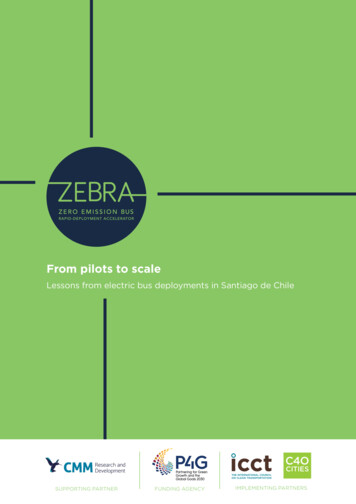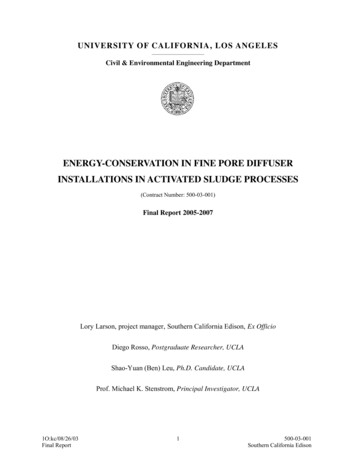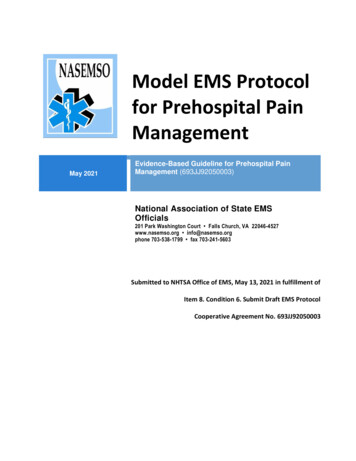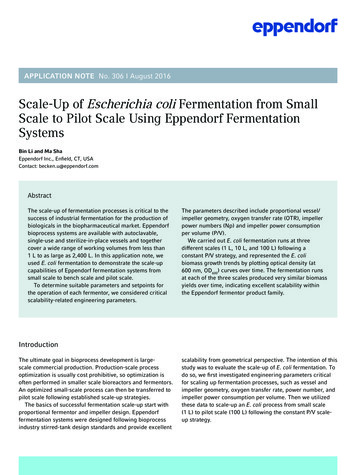
Transcription
From pilots to scaleLessons from electric bus deployments in Santiago de ChileC4OCITIESSUPPORTING PARTNERFUNDING AGENCYIMPLEMENTING PARTNERS
Author: Sebastián Galarza, Transport & Energy Sector Lead, CMM ChileSpecial Thanks: Ray Minjares and Oscar Delgado of ICCT, Marcela Castillo ofCMM Chile, and Manuel Olivera, Thomas Maltese, and Gabriel Olivera of C40ZEBRA: The ZEBRA (Zero Emission Bus Rapid-deployment Accelerator)partnership works to accelerate the deployment of zero emission buses inLatin American cities, with the final aim to achieve climate goals, improveurban air quality, and the overall standard of public transport. ZEBRA is aP4G funded partnership led by the ICCT and C40 Cities, and supported byCMM-Chile and WRI.IEA: The current case study is published in conjunction with the InternationalEnergy Agency’s Global Electric Vehicle Outlook 2020, in view of the e-busdeployment case studies analyzed in the publication.For further information regarding this case study, please contact SebastianGalarza at sgalarza@cmmolina.cl.
CONTENTI.Introduction. 2II.Tackling transportation emissions through regulation and improved vehicle technology . 2III. Electric bus deployments in Santiago de Chile . 3IV.Lessons learned . 81
I. INTRODUCTIONSantiago de Chile is one of the largest metropolitan areas in South America.Located in the valley of the Mapocho river surrounded by the Andes and thecoastal mountain ranges of Chile’s central valley, it is home to over 7 million—more than 40% of Chile’s population—and South America’s highest skyscraper.Additionally, since the beginning of 2019, Santiago is home to the largest fleetof electric buses outside of China. How did the city become a global leaderin the adoption of electric public transport? What lessons can we learn fromSantiago and what does the future of public transit in Chile look like? We seekto answer these and other questions in this case study.II. TACKLING TRANSPORTATION EMISSIONS THROUGHREGULATION AND IMPROVED VEHICLE TECHNOLOGYSantiago de Chile is not dissimilar from other megacities in so-called emergingeconomies. The latter half of the 20th century brought economic growth, urbansprawl, and an exponential growth in the number of private vehicles, and withthis came higher levels of congestion and air pollution. By the early 1990s,the city was one of the most polluted capital cities in all of Latin America.As a result, Chile began to monitor air pollution, regulate emissions from thetransportation sector, and integrate Santiago’s public transportation operatorsinto a unified system under the purview of a public transportation authority.Since then, Chile has played a pioneering role in the region in the adoption ofvehicle emission standards, as reflected in the composition of its urban bus fleet(see Figure 1). In 2018, Santiago became the first city in Latin America to adoptEuro VI emission standards for its public transportation system, and this helpedset the stage for electric bus deployments in subsequent years. By March 2020,Santiago had already deployed close to 600 Euro VI buses and more than 400electric buses—the latter making up approximately 6% of the fleet. This city hasset a target of full electrification by 2035.1 This is an effort to reduce exposureto local pollutants from the transportation network and, in particular, to reduceCO2 emissions, which have increased over time (see Table 1).2
9000Euro IEuro IIEuro IIIEuro III DPFEuro VEuro VIBEB8000# of buses700060005000400030002000100002006 2007 2008 2009 2010201120122013201420152016201720182019Figure 1. Evolution of urban bus emission control technologies in Santiago (Directorio de TransportePúblico Metropolitano, 2011, 2012 & 2018). 2Table 1. Emissions from Transantiago, 2012–2018 79.6460,786% Change-23.8%-27.6%-8.8%1.8%-20.9%3.0%III. ELECTRIC BUS DEPLOYMENTS IN SANTIAGO DE CHILEIn 2007, after an ambitious transportation reform, Santiago launched itsrestructured public transport system, Transantiago (now known as RedMetropolitana de Movilidad, or RED). Today RED is made up of 380 routesoperated by six private operators; it has the capacity to move 690,954passengers with its fleet of 6,756 buses on a network that spans more than2,946 kilometers (see Table 2 for additional statistics.) The operators haveto meet performance requirements as part of their obligations to the localtransport authority.4 The system has been criticized and is currently beingreformed to correct many of its structural failures; these reforms include,among others, disaggregating fleet provision from operation, smaller businessunits, shorter contracts, and incentives for electric bus operations. All thesame, Santiago has been at the forefront of large-scale new vehicle technologydeployments in Latin America, including electric vehicles. Santiago’s electric3
bus journey began with early demonstration projects in 2011 and 2013 andcontinued through 2017, a pivotal year in terms of electric bus pilot projects. 5Table 2. Transantiago network statistics, 2012–2018 62012201320142015201620172018Number of buses6,2986,4936,5136,5506,6466,6816,756Number of 6,685682,642685,257690,954Passenger capacityDistance traveled (million km)Length of bus network 2,8342,946In November 2017, Metbus, one of Santiago’s private bus operators, partneredwith Enel, an Italian utility company, and BYD to bring two electric 12 meter (m)BYD K9FE buses to operate under regular service in Santiago. The two busesran for a year with five trained drivers on route 516, which takes approximately4–4.5 hours to complete. Over the year, they covered 105,981 km and movedmore than 350,000 passengers with an availability ratio of 99.23% (1,665return legs were completed, 13 return legs were not). Operating costs werecalculated at 0.10/km, based on a 0.10/kilowatt hour (kWh) price and anenergy consumption of 1.006 kWh/km. In comparison, a diesel reference buswith an energy consumption of 0.5 liters/km operates at a cost of 0.86 perliter.7As a result of this pilot, Metbus worked with BYD and Enel X, an Enelsubsidiary, to scale the operation by adding an additional 100 BYD K9FE unitsin 2019. Enel X acted as the financial agent and energy provider, and leasedthe buses to Metbus for 10 years; Metbus, in turn, operates the buses andprovides basic maintenance, while BYD is in charge of more importantmaintenance operations including battery packs and electric drive trains. Forthe latter, Metbus negotiated a fixed maintenance rate of 0.09/km with BYDand there is an availability clause whereby the manufacturer is responsible forany fines incurred by buses that do not meet frequency requirements.8The total amount of the agreement between Metbus and Enel X is estimated tobe in the range of 40 million.9 This includes a financial lease for 100 buses andcharging infrastructure for 10 years, after which the assets are transferred tothe lessee, Metbus. The amount also includes the costs associated with gridupgrades in two “electroterminals”; these are estimated to have been in therange of 3 million in each depot.10 The BYD K9FE buses cost an estimated 295,000 per unit.11 As for the charging infrastructure, Metbus secured 100BYD EVA 080KI AC chargers that deliver up to 80 kW and have an estimated4
PHOTO BY MARCELA CASTILLOcharge time of 3–4 hours when connected with two charge cables undercombined charging system (CCS) protocols for an additional 3,700 per unit.12Enel and Metbus have also signed an agreement to provide certified renewableenergy at a 40% discount— approximately 0.06 per kW.13 Furthermore, thesebuses have been used to create Latin America’s first electric corridor: a busroute along a major axis in Santiago, Avenida Grecia, that is operated solelywith electric buses. The corridor contains 40 new state-of-the-art bus stopswhich include free wifi, USB chargers, bus arrival time panels, solar panelsto cover electricity demands, LED lighting, wheelchair access, and, in somestations, exclusive payment zones. The partnership has been so fruitful thatMetbus has increased its fleet to 285 BYD K9FE and is planning to add anadditional 150 of these buses during 2020.14Also in 2017, a similar partnership, this time led by Engie, a French utilitycompany with operations in Chile, and Gildemeister, a local automobile dealer,launched a Yutong E12 (also known as ZK 6128) 12-meter low-floor bus pilotin Santiago. Buses Vule, a Transantiago operator, joined the initiative andoperated the bus between December 2017 and May 2018; the bus completed5
1,173 trips and traveled a total of 22,055 km.15 By June 2019, the bus hadcovered more than 100,000 km and had estimated operational costs of around 0.05 per km.16In late 2018, as a result of this successful pilot program, Engie announcedthat it would finance an additional 100 battery electric buses and work withtwo Transantiago operators—Buses Vule and STP. The total cost of theseagreements is estimated to have been more than 30 million for the busesalone, meaning the unit price per bus was about 300,000.17 Other estimatesof the price of the Yutong E12 buses have been between 320,000 and 350,000 per unit.18 In this agreement, Engie acted as the financial agentand provided charging infrastructure and certified renewable energy for bothbus operators—3.3 gigawatt hours (GWh) per year for STP and 8.8 GWh peryear for Buses Vule.19 The STP terminal will have 13 150 kW DC chargers tooperate 25 electric buses. 20 The Buses Vule terminal at Rinconada, whichopened in March 2019, includes 37 150 kW DC chargers capable of handlingthe operation of 75 electric buses. The total cost per charger has not beenreleased, but it is estimated to be in the range of 20,000 to 40,000 perunit. The total energy demand for the terminal is estimated to be 6 megawatt(MW) and includes a 2.1 MW backup system. 21 In April 2019, these buses wereintegrated into regular operations.Most recently, in March 2020, NEoT Green Mobility, an investment platformdedicated to financing zero-emission mobility, financed 25 King LongDM2800 electric 12 m buses to be used in Redbus’ (a Transdev company)operations. Details regarding the financial agreement are limited, but theymirror the Engie/Enel business model of providing separate asset ownershipfor infrastructure and buses to a local transport operator. STP is also seekingto add 215 electric buses to its fleet, this time in conjunction with Foton,represented by Andes Motors in Chile, and COPEC, a local fuel distributioncompany. Details of this are still scarce, but contracts have been finalized. 22Importantly, this not only brings new financial actors to the sector but alsoincorporates new electric bus manufacturers within Santiago’s transportoperations. At the time of writing, there are 11 type-approved electric buses forChile, including two A1 buses (8–11 m) and one C2 bus (18 m) from five differentChinese manufacturers (see Table 3). Articulated buses (18 m) have beentested in Santiago from at least two different manufacturers, BYD and Sunwin,but have not been incorporated into any fleets thus far. 236
Table 3. Electric buses approved for RED operations (MTT 06/2020)30Bus yEnergyconsumption31[kWh/km]Range[km/charge]BYDK9 .48219.7101B2A1FOTONBYDeBus U12 QCK7EBus U8,5FOTONQCZHONGTONG A.N.A.N.A.N.A.N.A.N.A.ChargerBYD EVA080KIcharger, AC80kW, CCS 1standard150kW icleClassBrandB2A1B2Operation[# of buses]285 150(ExpectedQ2-Q32020)OperatorRoutesMetbus507c, 516,519Buses Vule, 213e, I09,STPI09c, I09eB2KING LONGXMQ 6127GPLUS280374.65901.74215.025RedbusA1KING LONGXMQ 6900G200210.56451.13186N.A.N.A.C2ZHONGTONG LCK6180EVG300525.111412.67196N.A.N.A.A2ZHONGTONG dQ2-Q32020)STP(expected)B2FOTONeBus U12 SC350385.08901.63N.A.ABB HVC150C, 150kWCO2,CO2c, C06,DepotC14box, CCS 2standardUnknown,N.A.CCS 2standardUnknown,N.A.CCS 2standardUnknown,N.A.CCS 2standardN.A.Unknown,CCS 2standardChargingstrategyOvernight,4-4.5 hoursat depotOvernight,2.5-3 hoursat depotN.A.N.A.N.A.N.A.Overnight,2.5-3 hoursat depotN.A.N.A.N.A.N.A.7
PHOTO BY MARCELA CASTILLOIV. LESSONS LEARNEDThe notable growth in the number of electric buses on Santiago’s streets in thepast couple of years has generated positive outcomes. Preliminary calculationsshow emissions reductions on the order of 2,561.1 tonnes of CO2e from3,658,388 km operated with 100 electric buses from Metbus. 24 Extrapolatingthis to the current fleet of 411 battery electric buses, these have reduced closeto 20,630 tonnes of CO2e, or around a 5% reduction in CO2 emissions from2018 levels. 25 Public transit users also view electric buses in a favorable light,and gave them a score of 6.3 out of 7; that is higher than Euro VI buses, whichreceived a score of 5.8, and the public transportation system as a whole,which received a 4.3. 26 Based on frequency and availability metrics providedby operators, the reliability of operations with electric buses is in line with orsuperior to those from conventional buses.The economic impact of electric bus deployment is still unclear. However,operational costs released by operators show substantial reductions vis-à-visconventional buses. Moreover, the continued incorporation (at scale) of electricbuses into the fleet, which is expected to increase to more than 800 in 2020,sends a strong market signal.8
It is important to note that this deployment in Santiago was accomplishedoutside of fleet renewal tenders and by taking advantage of contractextensions to current operators. It was not through competitive bidding.Overall, Santiago has struggled, as have many other cities in South America, torenew its transport fleet over the past few years. Tenders have been desertedand modified. At the time of writing, there is an open tender to renew morethan 2,000 buses and also make substantial changes in the structure of thetransportation system.The new system seeks to split the ownership and operation of assets byhaving fleet suppliers and bus operators, while the transport authoritymanages depots. Embedded in the current tender are several incentivesfor electric buses. Fleet suppliers can obtain fleet contracts for 10 yearsfor internal combustion engines and for electric buses, it is extended to14 years. Operators, which will lease buses from suppliers, will be granted5-year contracts that are extendable for up to an additional 5 years basedon performance factors. Importantly, if the base operational fleet of theseoperators is made up primarily of electric buses, i.e., more than 50%, thanthese contracts are granted for 7 years, and are extendable for another 7based on performance indicators. A sliding scale point system is also includedbased on energy consumption (megajoules/km) that is calculated based onperformance on the TS-STGO drive cycle. 27 Santiago is the first city in LatinAmerica to develop its own drive cycle for urban buses type approval. 28Importantly, this is the first tender in Santiago where we will see diesel busescompete alongside electric buses. Other tenders have been technologyspecific. While it is unclear how many of the new buses will be electric, recallthat there is a mandate to fully electrify by 2035.Further challenges to the advancement of electric public transport remain.The exponential growth of this vehicle segment preceded many regulatoryconsiderations, particularly regarding charging standards and interoperabilityrequirements. The economic viability of substantially increasing the numberof electric buses is also unclear, given the current economic and socialpressures currently weighing on the heavily subsidized system in Santiago.However, the arrival of new actors and business models adds a new impetusfor these technologies. Infrastructure challenges also remain. These includeensuring more dedicated bus lanes to increase passenger uptake and improvefrequencies for the bus network as a whole, and also grid upgrades at depotsthat are necessary to handle peak loads. Currently, there are already 10 electric9
bus depots with over 22 MW of installed capacity (see Table 4) to operate 411electric buses out of a total fleet of just under 6,800 buses. Although many ofthese lessons are transferable to other cities in emerging economies, structuralchallenges, particularly the formalization of urban bus operators, remains akey building block for these large-scale deployments, and that process is notdependent on technology but rather on political will. This is the case in mostcities in Chile outside of Santiago, which have the challenge of electrifying theirentire fleets by 2040—a goal set by the central government. 29Table 4. RED electric bus depots, chargers and installed capacityDepot NameChargersInstalled capacity (MW)Peñalolén65 (1x80kWAC)5.2Los Acacios37 (1x80kWAC)2.4Los Pinos37 (1x80kWAC)3Las Palmas13 (1x80kWAC)1.25El Salto5 (3x50kWDC)0.75Nueva Bilbao (1)3 (3x50kWDC)0.5Nueva Bilbao (2)3 (4x40kWDC)0.51 (350kW x150kWDC)2.1214 Chargers22.1 MW total installed capacityI D Peñalolén10 Depots10
Figure 2. Electric bus routes in Santiago de Chile. Buses Vule (I09, I09c, I09e) is shown in green, Metbus(507c, 516, 519) is shown in cyan, Redbus (CO2, CO2c, C06, C14), and STP (213e) is shown in yellow.
1See o.pdf2See tpm.cl/archivos/Informe de gestión 2012 4 de Septiembre.pdf and http://www.dtpm.cl/descargas/memoria/Informe Gestion 2018 DTPM.pdf3See http://www.dtpm.cl/descargas/memoria/Informe Gestion 2018 DTPM.pdf4Previously seven but Alsacia S.A declared bankruptcy in 2014 and was removed from the system in 2018. See d and Electric Bus Test Program, conceived by C40 and the Clinton Climate Initiative, and supported by the InterAmerican Development Bank with a financial contribution of 1.49 million. Also, See See http://www.dtpm.cl/descargas/memoria/Informe Gestion 2018 DTPM.pdf7See a-prueba/8Maintenance costs per/km for diesel buses run at around 0.27, as estimated by METBUS. See cion-de-buses-electricos-en-santiagochile/9See asp?id 52247510 It is unclear if these costs were included in the financial lease or rather in a separate agreement between both parties.11See cion-debuses-electricos-en-santiago-chile/12 Ibid.13 See cion-debuses-electricos-en-santiago-chile/14 Based on conversations with Metbus on March 2, 2020.15 DTPM presentation at CMM-DTPM workshop (June 2018)16 See lectricos-deyutong/17 See rma-china/18 See cos-delmundo/219064/19 See eselectricos-del-transantiago/20 See eltransantiago/21 See /22 Based on conversations held on April 23, 2020 with Andes Motors.23 See ctrico-articulado/644852/ and -del-transantiago/24 See -empresas-que-usan-electromovilidad25 Own calculations including the use of renewable energy.26 See 3%B3n-Nuevo-Est%C3%A1ndar vF.pdf27 TS-STGO is a city specific drive cycle for Santiago developed by the Ministry of Transport, Centro Mario Molina, VTT,Sweden’s Trafikverket among others as part of IEAs Advanced Motor Fuel’s Technology Cooperation Programme’s Annex53-1 on Sustainable Bus Systems. Final report available at ex%20Reports/AMF Annex 53-1.pdf28 Resolución Exenta N 2.243 de 2018 del Ministerio de Transportes y Telecomunicaciones available at https://www.leychile.cl/Navegar?idNorma 112138429 See liticas-publicas30 See MTT/3CV umo-Energetico-Buses-Electricos WEB.xls31 Energy consumption calculated based on TS-STGO drive cycle as per Resolución Exenta N 2.243 de 2018 del Ministeriode Transportes y Telecomunicaciones available at https://www.leychile.cl/Navegar?idNorma 112138412
ORTING PARTNERFUNDING AGENCYIMPLEMENTING PARTNERS
Author: Sebastián Galarza, Transport & Energy Sector Lead, CMM Chile Special Thanks: Ray Minjares and Oscar Delgado of ICCT, Marcela Castillo of CMM Chile, and Manuel Olivera, Thomas Maltese, and Gabriel Olivera of C40 ZEBRA: The ZEBRA (Zero Emission Bus Rapid-deployment Accelerator) partnership works to accelerate the deployment of zero emission buses in











